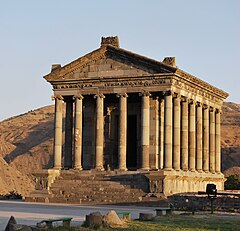Garni Temple
| Temple of Garni | |
|---|---|

The temple in 2013
|
|
|
Location within Armenia
|
|
| General information | |
| Status | Museum (as part of a larger protected area) occasional neopagan shrine |
| Type | Pagan temple or tomb |
| Architectural style | Ancient Greek, Greco-Roman, Armenian influence |
| Location | Garni, Kotayk Province, Armenia |
| Coordinates | 40°06′45″N 44°43′49″E / 40.112421°N 44.730277°ECoordinates: 40°06′45″N 44°43′49″E / 40.112421°N 44.730277°E |
| Elevation | 1,396 m (4,580 ft) |
| Completed | First or second century AD |
| Owner | Armenian Ministry of Culture |
The Temple of Garni (Armenian: Գառնիի հեթանոսական տաճար Gařnii het’anosakan tačar, lit. "pagan temple of Garni") is a classical Hellenistic temple in Garni, Armenia. It is perhaps the best-known structure and symbol of pre-Christian Armenia. It is the only standing Greco-Roman colonnaded building in Armenia and the former Soviet Union.
The structure was probably built by king Tiridates I in the first century AD as a temple to the sun god Mihr. After Armenia's conversion to Christianity in the early fourth century, it was converted into a royal summer house of Khosrovidukht, the sister of Tiridates III. According to some scholars it was not a temple but a tomb and thus survived the universal destruction of pagan structures. It collapsed in a 1679 earthquake. Renewed interest in the 19th century led to excavations at the site in early and mid-20th century and its eventual reconstruction between 1969 and 1975. It is one of the main tourist attractions in Armenia and the central shrine of Armenian neopaganism.
The temple is at the edge of a triangular cliff and is part of the fortress of Garni (Armenian: Գառնիի ամրոց, Gařnii amrots or Գառնու ամրոց, Gařnu amrots). One of the oldest fortresses in Armenia, it is mentioned as Gorneas in the first-century Annals of Tacitus. The site is near the village of Garni, in Armenia's Kotayk Province and is officially known as the Garni Historical and Cultural Museum Reserve (Armenian: «Գառնի» պատմա-մշակութային արգելոց-թանգարան), which includes the temple, a bath complex, a royal summer palace, the seventh century church of St. Sion and other minor items (e.g., medieval khachkars). In total, the list of intangible historical and cultural monuments approved by the government of Armenia includes 11 items. It occupies 3.5 hectares (8.6 acres) and is supervised by the Service for the Protection of Historical Environment and Cultural Museum Reservations, an agency attached to the Ministry of Culture of the Republic of Armenia.
...
Wikipedia

